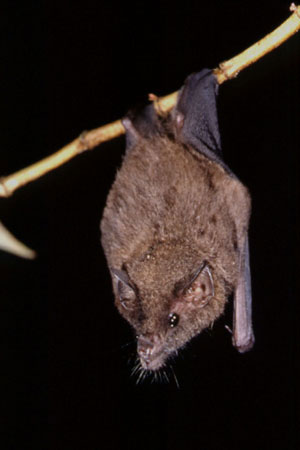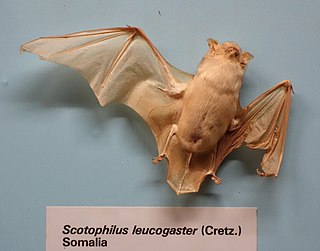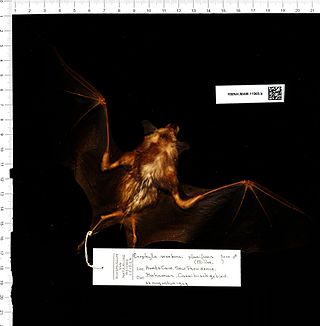
The New World leaf-nosed bats (Phyllostomidae) are found from southern North America to South America, specifically from the Southwest United States to northern Argentina. They are ecologically the most varied and diverse family within the order Chiroptera. Most species are insectivorous, but the phyllostomid bats include within their number true predatory species and frugivores. For example, the spectral bat, the largest bat in the Americas, eats vertebrate prey, including small, dove-sized birds. Members of this family have evolved to use food groups such as fruit, nectar, pollen, insects, frogs, other bats, and small vertebrates, and in the case of the vampire bats, even blood.

The Jamaican, common or Mexican fruit bat is a fruit-eating bat native to the Neotropics.

The pallid bat is a species of bat that ranges from western Canada to central Mexico. It is the sole species of its genus and is closely related to Van Gelder's bat, which is sometimes included in Antrozous. Although it has in the past been placed in its own subfamily (Antrozoinae) or even family (Antrozoidae), it is now considered part of the subfamily Vespertilioninae and the tribe Antrozoini.

Geoffroy's tailless bat is a species of phyllostomid bat from the American tropics.

Dekeyser's nectar bat is a bat species found in Brazil and Bolivia.

The long-legged bat is a member of the Phyllostomidae family in the order Chiroptera. Both males and females of this species are generally small, with wingspans reaching 80mm with an average weight ranging between 6 and 9 grams. The facial structure of these bats includes a shortened rostrum with a prominent noseleaf. The most defining feature of these bats however, is their long posterior limbs that extend farther than most Phyllostomidae bats. At the ends of these hind legs, the long-legged bat has abnormally large feet equipped with strong claws.

The little big-eared bat is a bat species in the order Chiroptera and family Phyllostomidae. It is from South and Central America particularly Colombia, Venezuela, Guyana, French Guiana, Brazil, Peru, Ecuador, Bolivia, Argentina, Paraguay, Suriname and Trinidad. Though its exact population is unknown, it is considered widespread and occurs in protected areas, although deforestation may be a minor threat, it is classified as Least Concern. It is found in multistratal evergreen forests and dry thorn forests and forages near streams and is found hollow trees, logs, caverns, or houses with groups up to twelve. The head and body length measures at 44 millimetres (1.7 in) for males and 45 millimetres (1.8 in) for females. Males usually weigh about 5 grams (0.18 oz) while females weigh 5.7 grams (0.20 oz).

The greater spear-nosed bat is a bat species of the family Phyllostomidae from South and Central America. It is one of the larger bats of this region and is omnivorous.

The eastern or Queensland tube-nosed bat is a megabat in the family Pteropodidae that lives in north-eastern Australia. N. robinsoni is one of the few species of megabat that roosts solitarily. They get their common name from their raised tubular nostrils which are unlike those of most other species in the family. They are a deep brown with gray heads and sparse yellow spotting.

The Antillean fruit-eating bat is one of two leaf-nosed bat species belonging to the genus Brachyphylla. The species occurs in the Caribbean from Puerto Rico to St. Vincent and Barbados. Fossil specimens have also been recorded from New Providence, Bahamas.

The white-bellied yellow bat or white-bellied house bat, is a species of vesper bat in the genus Scotophilus, the house bats. It can be found in Angola, Benin, Botswana, Burkina Faso, Cameroon, Central African Republic, Chad, Ivory Coast, Gambia, Ghana, Guinea, Guinea-Bissau, Kenya, Mali, Mauritania, Namibia, Niger, Nigeria, Senegal, Sierra Leone, Sudan, Togo, Uganda, and Zambia. It is found in dry and moist savanna and open woodland. It is a common species with a very wide range, and the International Union for Conservation of Nature has assessed its conservation status as being of "least concern".

The buffy flower bat is a species of bat in the leaf-nosed bat family, Phyllostomidae. It is found in the Bahamas, the Cayman Islands, Cuba, and Jamaica.

Erophylla is a genus of bat in the family Phyllostomidae. It contains the following species:

Leach's single leaf bat, also known as Greater Antillean long-tongued bat, is a species of bat in the family Phyllostomidae. It is found in the southern Bahamas and in all the Greater Antilles. It forms large colonies, with up to a few hundred thousand individuals, and feeds on a relatively wide variety of food items including pollen, nectar, fruit and insects.

The banana bat is an endangered species of bat in the family Phyllostomidae. It is also commonly known as the trumpet-nosed bat or the Colima long-nosed bat.

The Jamaican flower bat is a critically endangered species of bat in the family Phyllostomidae. It is endemic to Jamaica.

The Cuban flower bat, also called Poey's flower bat, is a species of bat in the family Phyllostomidae. It is found on the Caribbean islands of Cuba and Hispaniola.

The Madagascan flying fox, Madagascar flying-fox, or Madagascar fruit bat is a species of megabat in the genus Pteropus. It is endemic to Madagascar. Its natural habitats are diverse, and include moist lowland forests, dry forests, succulent woodlands, and spiny thickets, and mangroves. It eats figs and other fruits, flowers, and leaves. It is threatened by habitat loss.

The Samoa flying fox or Samoan flying fox is a species of flying fox in the family Pteropodidae. It is found in American Samoa, Fiji, and Samoa. Its natural habitat is subtropical or tropical dry forests.

The cave nectar bat, dawn bat, common dawn bat, common nectar bat or lesser dawn bat is a species of megabat within the genus Eonycteris. The scientific name of the species was first published by Dobson in 1871.





















